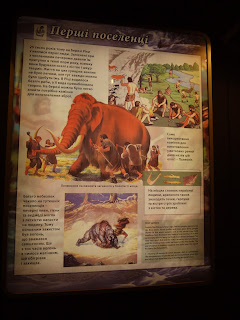In spring, 2010, in L'viv, Ukraine, Eugene Chervony (above), a young scientist, attended one of my workshops about creating a visitor-friendly museum. He then followed up with an invitation to visit his museum, the Natural History Museum in L'viv and talk about projects, so of course I did. At that point, his museum has been closed for renovation for twenty (that's right, twenty) years. Amidst bits of construction debris, seemingly almost finished spaces and taxidermied animals stuffed into storage areas we walked, talking about some of his ideas for the future. But how could it happen? No space, an organization with no real plan for the future, no money...there was a long list of seemingly unsurmountable nos.
But last month, I was back in L'viv and saw Eugene's new exhibit, The Story of One River at the History Museum (not at the still-closed Natural History Museum). The exhibit looks at the history of a river in L'viv in terms of not just science, but in terms of the river's impact on humans and our impact on the river (now wholly underground and essentially, a part of the city's waste disposal system). And, quite unusually still, his exhibit incorporated English language text for international visitors. How did this exhibit happen?
Eugene was good enough to share some of his thoughts on this project with me. In Ukraine, scientists (and museum curators) are really specialists so a broad-based exhibit like this is unusual. I asked,
How did you come up with the idea? He replied,
From MATRA partners [Note: a Dutch program supporting various efforts in Ukraine] we got a task [note: and supporting funding] to make an exhibition about co-existence of humans and nature and their influence an each other. So we thought about what we should to do. In my opinion we should present exhibition one story. The best example is a story about our river. As I am biologist all nature belong to sphere of my work. And design and project management is what I like to do because it is a process of creation and every time it is something new, some new tasks, some new ideas and problems. You can't be bored.
And how/why did you decide to connect it to the present day?
Collaboration is not usual in Ukraine, so I asked, "How did you convince the history museum to partner with you?--and your own museum to participate? He also mentioned that the agreement to participate took longer than he had hoped--like almost any partnership.It is not a finished story and we are still part of this story. Children who are the target group should understand that every action have consequences and you need to think to do or not.
They were interested to participate because it was supposed to be new kind of exhibition in the collaboration of Natural History museum and History museum. And also we promised new approach in exhibition design. Our museum has partners from Netherlands and also we are specializing on ecology and environmental problems.
Everything was made by museum workers. The artist I found from my friends. I did research on who doing art projects in L'viv and outside what dedicated to river and get whole network of connections. Some of them disappointed me and but some I enjoyed to work with them. With translations my American and Canadian friends helped me and I need to say big THANK YOU.But the hardest thing to accomplish was to convince his colleagues of the art object (see above) and of its relevance to the exhibition. Although people were interested in new ways of exhibit design, the reality is sometimes a bit harder--and really required, Eugene said, "a big fight" to install the art.
He would try and do a couple things differently (and what exhibit developer has ever done an exhibit that isn't the same?). Those included these three:
The exhibit ends with a space for visitor feedback on Post-It notes and I was curious about the comments. Eugene wrote this about visitor response:Probably I would change little bit of way of presentation of information about river.
I would start full evaluation from the beginning but I didn't have the time and or experience for it.
I would not present so many animals without any background but ....
What are the takeaways from Eugene's exhibit project? To me, they are:Children like to write feedback very much.
A 5th grade pupil wrote: I did not think that in Ukraine can be like in the USA. (about exhibition)
Government should open this problem (talk about it more)
But most of them are thanks and best wishes.
- Look inside and outside your own organization for skills, partners, and inspiration.
- Work collaboratively and persistently, believing that both new and long-term colleagues can be valuable members of a team.
- Don't be afraid to think that you can learn something new--and just try those new things (as the Little Engine that Could would say, "I think I can, I think I can.")
- Think about audiences--that should go without saying, but it's a bit of a new concept in Ukraine and too often, a new concept other places. Eugene had a message he wanted to convey to children, and evaluation shows they're getting it.










